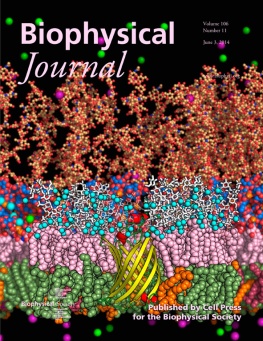When many of us think of a biological membrane on the molecular scale we picture a textbook image of a symmetric phospholipid bilayer that looks somewhat uncomplicated. The outer membrane of gram-negative bacteria is anything but symmetric and simple. We wanted the cover image to convey the molecular complexity and asymmetry of the outer membrane that these bacteria have as their first line of defense from their immediate environment.
The cover image for this issue illustrates a typical E. coli outer membrane and the molecular system that we used to represent the complexity in molecular dynamics simulations. In the image the diffuse background molecules represent the bilayer composed of (from the top, external leaflet) glycosylated amphipathic molecules known as lipopolysaccharide (LPS) consisting of an O-antigen polysaccharide (small red and orange spheres), a core oligosaccharide (red and blue spheres), and lipid A (pink spheres) and (the bottom, periplasmic leaflet) various phospholipid molecules (green, orange, and magenta spheres).
The sharply focused atoms in the foreground represent the molecular system we used in our simulations. Here the LPS contains only the core oligosaccharide (white sticks) and lipid A (pink spheres). The cyan atoms interspersed with the core oligosaccharides are calcium atoms, which immobilized the membrane by mediating the cross-linking electrostatic interaction network. The ÿ-barrel protein shown as a yellow ribbon diagram represents outer membrane phospholipase A (OmpLA), a typical integral outer membrane protein. We chose this protein for our simulations because it has been extensively studied experimentally in synthetic phospholipid membranes.
We wanted to investigate the microscopic environment of OmpLA in a native E. coli asymmetric membrane, especially the thickness of the hydrophobic region and the interaction of core oligosaccharides with external loops of the protein. Currently it is not possible to create an experimental asymmetric membrane with the complexity found in nature and in silico studies are the only way to study this system.
Please visit http://im.bioinformatics.ku.edu (Wonpil Im) and http://pages.jh.edu/~fleming/frontpage.html (Karen G. Fleming) for more information on our research interests.
–Emilia L. Wu, Patrick J. Fleming, Min Sun Yeom, Göran Widmalm, Jeffery B. Klauda, Karen G. Fleming, and Wonpil Im
